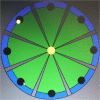Effects of upper limb robot-assisted therapy on motor recovery in subacute stroke patients
- PMID: 24946799
- PMCID: PMC4074149
- DOI: 10.1186/1743-0003-11-104
Effects of upper limb robot-assisted therapy on motor recovery in subacute stroke patients
Abstract
Background and purpose: There is little evidence available on the use of robot-assisted therapy in subacute stroke patients. A randomized controlled trial was carried out to evaluate the short-time efficacy of intensive robot-assisted therapy compared to usual physical therapy performed in the early phase after stroke onset.
Methods: Fifty-three subacute stroke patients at their first-ever stroke were enrolled 30 ± 7 days after the acute event and randomized into two groups, both exposed to standard therapy. Additional 30 sessions of robot-assisted therapy were provided to the Experimental Group. Additional 30 sessions of usual therapy were provided to the Control Group.The following impairment evaluations were performed at the beginning (T0), after 15 sessions (T1), and at the end of the treatment (T2): Fugl-Meyer Assessment Scale (FM), Modified Ashworth Scale-Shoulder (MAS-S), Modified Ashworth Scale-Elbow (MAS-E), Total Passive Range of Motion-Shoulder/Elbow (pROM), and Motricity Index (MI).
Results: Evidence of significant improvements in MAS-S (p = 0.004), MAS-E (p = 0.018) and pROM (p < 0.0001) was found in the Experimental Group. Significant improvement was demonstrated in both Experimental and Control Group in FM (EG: p < 0.0001, CG: p < 0.0001) and MI (EG: p < 0.0001, CG: p < 0.0001), with an higher improvement in the Experimental Group.
Conclusions: Robot-assisted upper limb rehabilitation treatment can contribute to increasing motor recovery in subacute stroke patients. Focusing on the early phase of stroke recovery has a high potential impact in clinical practice.
Figures
References
-
- Mayo NE, Wood-Dauphinee S, Ahmed S, Gordon C, Higgins J, McEwen S, Salbach N. Disablement following stroke. Disabil Rehabil. 1999;21(5–6):258–268. - PubMed
-
- Franceschini M, Ceravolo MG, Agosti M, Cavallini P, Bonassi S, Dall’Armi V, Massucci M, Schifini F, Sale P. Clinical relevance of action observation in upper-limb stroke rehabilitation: a possible role in recovery of functional dexterity. A randomized clinical trial Neurorehabil Neural Repair. 2012;26(5):456–462. doi: 10.1177/1545968311427406. - DOI - PubMed
Publication types
MeSH terms
LinkOut - more resources
Full Text Sources
Other Literature Sources
Medical




